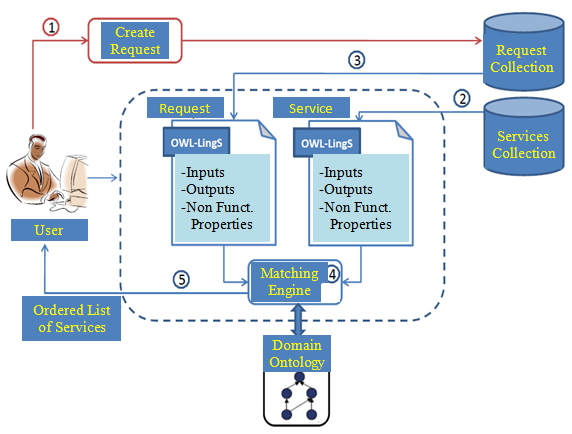Description of OWL-LingS-MX
- Overview
- OWL-LingS-MX Operation
- Overview
- OWL-LingS-MX Operation
OWL-LingS-MX (stands for OWL for Linguistic Services Matchmaker) is a matchmaker that promotes the discovery of Linguistic Web Services. It supports an extension of OWLS-MX for integrating the nonfunctional linguistic properties (e.g., Processing Level, Formalism, Phenonemon, and Approach.).
The proposed extension of the OWLS-MX matching algorithm is presented below.
The proposed algorithm is based on the OWLS-MX matching algorithm. It incorporates nonfunctional linguistic properties which can improve the discovery of Linguistic Web Services. Algorithm 1 shows the proposed algorithm (pseudo code). The generic OWLS-MX algorithm uses two main functions.
- The first is called CANDIDATESinputset which takes as parameters a set of inputs (i.e., INPUTSR) of the request. It aims to find registered services ‘S‘ with the most suitable inputs corresponding to the request inputs.
- The second one called CANDIDATESoutputset operates like CANDIDATES inputset but for the outputs, so it looks for registered services ‘S‘ with the best outputs corresponding to the request outputs.
The CANDIDATESinputset and CANDIDATESoutputset functions provide for each service two matching degrees (dom: stands for Degree Of Matching related to inputs and dom’: stands for Degree Of Matching related to outputs). Thus, the minimum degree between dom and dom’ of each service will be returned back.
Our extension consists in adding functions having the same principle of CANDIDATESinputset and CANDIDATESoutputset, hence each function deals with one nonfunctional linguistic property. For instance, the added functions are CANDIDATESPL for Processing Level, CANDIDATESRES for RESource, CANDIDATESFORM for FORMalism, CANDIDATESTreatT for Treatment Type, CANDIDATESAnalysisT for Analysis Type, CANDIDATESLANG for LANGuage, and CANDIDATESPH for PHenomenon (see statements lines 3 and 4 in Algorithm 1).
The index ‘i‘ of the CANDIDATESi method can be substituted with one property (e.g., RES or FORM). Hence, we obtain for example CANDIDATESRES or CANDIDATESFORM. Similarly, the index ‘i‘ of the domi attribute can be substituted with one property (e.g., PL and FORM), so we get domPL and domFORM respectively.
We extended the main algorithm of OWLS-MX using the same numerical values of the matching degrees (i.e., Exact, Plug-in, Subsumes, Subsumed-by, Nearest-neighbour). Thus, the matching degrees have been applied for the input and output types (e.g., Text, Phrase, and Word) as well as for the nonfunctional properties (e.g., phenomenon, resource, and approach).
The input parameter α is a given syntactic similarity threshold which is chosen by the user (α ∈ [0,1]). Each function returns back the matching degrees between a chosen nonfunctional linguistic property of a given pair of service advertisement and request.
 Top of Page
Top of PageIn the following, we present the main basics of the developed tool.

This request will be saved in the requests collection like a file with the following extension `owl-lings'.
(2) and (3) The user can import services from the services collection and desired request(s).
(4) The matching engine will select the most relevant services according to the request based on relations between the concepts of our domain ontology. This matching consider the inputs and outputs as well as the nonfunctional linguistic properties.
(5) A list of ordered services (by matching degree) is returned.